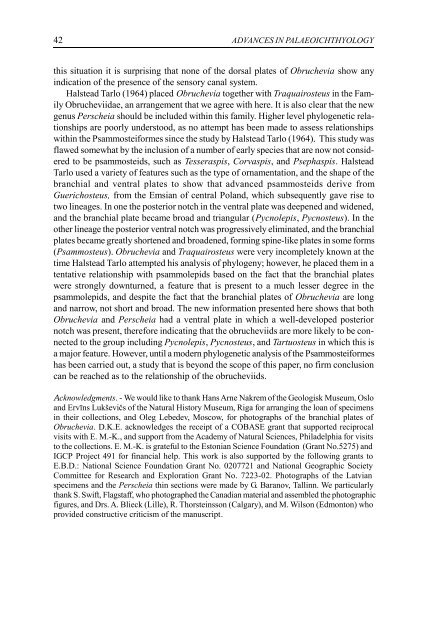Zemes un vides zinātnes Earth and Environment Sciences - Latvijas ...
Zemes un vides zinātnes Earth and Environment Sciences - Latvijas ...
Zemes un vides zinātnes Earth and Environment Sciences - Latvijas ...
Create successful ePaper yourself
Turn your PDF publications into a flip-book with our unique Google optimized e-Paper software.
42 ADVANCES IN PALAEOICHTHYOLOGY<br />
this situation it is surprising that none of the dorsal plates of Obruchevia show any<br />
indication of the presence of the sensory canal system.<br />
Halstead Tarlo (1964) placed Obruchevia together with Traquairosteus in the Family<br />
Obrucheviidae, an arrangement that we agree with here. It is also clear that the new<br />
genus Perscheia should be included within this family. Higher level phylogenetic relationships<br />
are poorly <strong>un</strong>derstood, as no attempt has been made to assess relationships<br />
within the Psammosteiformes since the study by Halstead Tarlo (1964). This study was<br />
flawed somewhat by the inclusion of a number of early species that are now not considered<br />
to be psammosteids, such as Tesseraspis, Corvaspis, <strong>and</strong> Psephaspis. Halstead<br />
Tarlo used a variety of features such as the type of ornamentation, <strong>and</strong> the shape of the<br />
branchial <strong>and</strong> ventral plates to show that advanced psammosteids derive from<br />
Guerichosteus, from the Emsian of central Pol<strong>and</strong>, which subsequently gave rise to<br />
two lineages. In one the posterior notch in the ventral plate was deepened <strong>and</strong> widened,<br />
<strong>and</strong> the branchial plate became broad <strong>and</strong> triangular (Pycnolepis, Pycnosteus). In the<br />
other lineage the posterior ventral notch was progressively eliminated, <strong>and</strong> the branchial<br />
plates became greatly shortened <strong>and</strong> broadened, forming spine-like plates in some forms<br />
(Psammosteus). Obruchevia <strong>and</strong> Traquairosteus were very incompletely known at the<br />
time Halstead Tarlo attempted his analysis of phylogeny; however, he placed them in a<br />
tentative relationship with psammolepids based on the fact that the branchial plates<br />
were strongly downturned, a feature that is present to a much lesser degree in the<br />
psammolepids, <strong>and</strong> despite the fact that the branchial plates of Obruchevia are long<br />
<strong>and</strong> narrow, not short <strong>and</strong> broad. The new information presented here shows that both<br />
Obruchevia <strong>and</strong> Perscheia had a ventral plate in which a well-developed posterior<br />
notch was present, therefore indicating that the obrucheviids are more likely to be connected<br />
to the group including Pycnolepis, Pycnosteus, <strong>and</strong> Tartuosteus in which this is<br />
a major feature. However, <strong>un</strong>til a modern phylogenetic analysis of the Psammosteiformes<br />
has been carried out, a study that is beyond the scope of this paper, no firm conclusion<br />
can be reached as to the relationship of the obrucheviids.<br />
Acknowledgments. - We would like to thank Hans Arne Nakrem of the Geologisk Museum, Oslo<br />
<strong>and</strong> Ervīns Lukševičs of the Natural History Museum, Riga for arranging the loan of specimens<br />
in their collections, <strong>and</strong> Oleg Lebedev, Moscow, for photographs of the branchial plates of<br />
Obruchevia. D.K.E. acknowledges the receipt of a COBASE grant that supported reciprocal<br />
visits with E. M.-K., <strong>and</strong> support from the Academy of Natural <strong>Sciences</strong>, Philadelphia for visits<br />
to the collections. E. M.-K. is grateful to the Estonian Science Fo<strong>un</strong>dation (Grant No.5275) <strong>and</strong><br />
IGCP Project 491 for financial help. This work is also supported by the following grants to<br />
E.B.D.: National Science Fo<strong>un</strong>dation Grant No. 0207721 <strong>and</strong> National Geographic Society<br />
Committee for Research <strong>and</strong> Exploration Grant No. 7223-02. Photographs of the Latvian<br />
specimens <strong>and</strong> the Perscheia thin sections were made by G. Baranov, Tallinn. We particularly<br />
thank S. Swift, Flagstaff, who photographed the Canadian material <strong>and</strong> assembled the photographic<br />
figures, <strong>and</strong> Drs. A. Blieck (Lille), R. Thorsteinsson (Calgary), <strong>and</strong> M. Wilson (Edmonton) who<br />
provided constructive criticism of the manuscript.
















